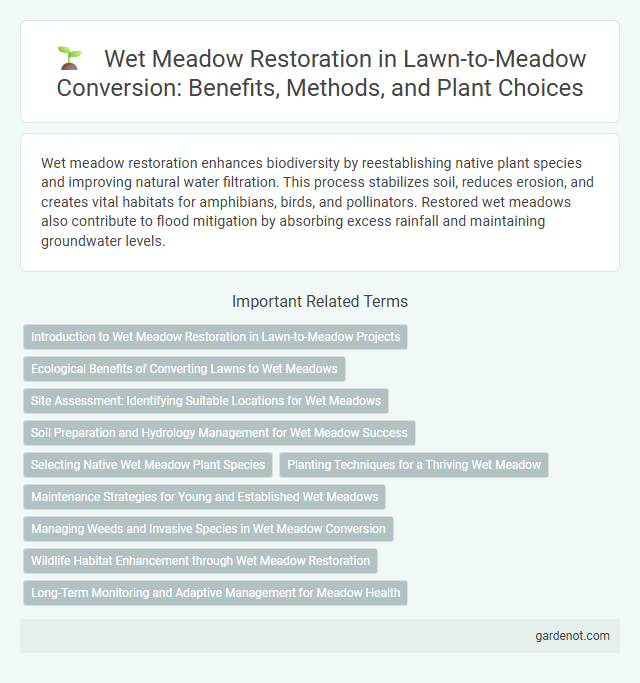Wet meadow restoration enhances biodiversity by reestablishing native plant species and improving natural water filtration. This process stabilizes soil, reduces erosion, and creates vital habitats for amphibians, birds, and pollinators. Restored wet meadows also contribute to flood mitigation by absorbing excess rainfall and maintaining groundwater levels.
Introduction to Wet Meadow Restoration in Lawn-to-Meadow Projects
Wet meadow restoration in lawn-to-meadow projects enhances biodiversity by reestablishing native hydrophilic plant species and improving soil moisture retention. This process involves removing turfgrass, adjusting soil hydrology, and planting native wet meadow flora such as cattails, sedges, and wildflowers. Restored wet meadows support pollinators, control stormwater runoff, and increase habitat complexity within urban and suburban landscapes.
Ecological Benefits of Converting Lawns to Wet Meadows
Converting lawns to wet meadows significantly enhances biodiversity by providing critical habitat for native plants, pollinators, and wildlife species, such as amphibians and migratory birds. This ecological restoration improves soil health and water retention, reducing runoff and filtering pollutants before they reach waterways. Wet meadow restoration also sequesters carbon effectively, contributing to climate change mitigation while supporting resilient ecosystems.
Site Assessment: Identifying Suitable Locations for Wet Meadows
Wet meadow restoration requires thorough site assessment to identify locations with appropriate hydrology, soil type, and native vegetation. Key indicators for suitable sites include seasonally saturated soils, minimal drainage, and presence of hydrophilic plant species. Evaluating topography, water flow patterns, and existing land use ensures optimal conditions for successful wet meadow ecosystem establishment.
Soil Preparation and Hydrology Management for Wet Meadow Success
Effective wet meadow restoration hinges on meticulous soil preparation and hydrology management to recreate natural water regimes and nutrient cycles. Soil aeration techniques, combined with organic matter amendments, enhance substrate permeability and support native wet meadow vegetation establishment. Precise hydrological controls such as installing water control structures and maintaining natural flooding regimes ensure optimal water retention essential for sustaining wet meadow ecosystems.
Selecting Native Wet Meadow Plant Species
Selecting native wet meadow plant species enhances ecosystem resilience and supports local biodiversity by providing habitat and food sources for native wildlife. Key species such as Carex stricta (tussock sedge), Juncus effusus (soft rush), and Lobelia cardinalis (cardinal flower) thrive in saturated soils and contribute to water filtration and erosion control. Prioritizing regionally adapted plants minimizes maintenance and promotes long-term stability in wet meadow restoration projects.
Planting Techniques for a Thriving Wet Meadow
Effective planting techniques for wet meadow restoration involve selecting native hydrophilic species that thrive in saturated soil conditions, ensuring ecological balance and habitat diversity. Using plug plants or seeds adapted to local hydrology enhances establishment success and resilience against invasive species. Incorporating seasonal timing and microtopography manipulation promotes optimal growth and water retention essential for sustaining a thriving wet meadow ecosystem.
Maintenance Strategies for Young and Established Wet Meadows
Effective wet meadow restoration relies on tailored maintenance strategies that vary between young and established meadows to ensure ecosystem resilience. Young wet meadows require frequent mowing combined with invasive species control to promote native plant establishment and enhance soil moisture retention. Established wet meadows benefit from periodic prescribed burns or selective grazing to maintain plant diversity, prevent woody encroachment, and sustain hydrological balance.
Managing Weeds and Invasive Species in Wet Meadow Conversion
Effective wet meadow restoration requires diligent management of weeds and invasive species to preserve native biodiversity and ecosystem function. Techniques such as manual removal, targeted herbicide application, and regular monitoring are critical to suppress aggressive invaders like reed canary grass and purple loosestrife. Establishing a diverse assemblage of native plants promotes resilience against invasions and supports long-term wet meadow health.
Wildlife Habitat Enhancement through Wet Meadow Restoration
Wet meadow restoration significantly enhances wildlife habitat by increasing plant diversity and creating optimal conditions for native species such as amphibians, waterfowl, and pollinators. Restored wetlands improve hydrological functions, providing nesting sites and seasonal food resources critical for biodiversity. These habitats support ecological resilience by sustaining a range of flora and fauna adapted to wet meadow environments.
Long-Term Monitoring and Adaptive Management for Meadow Health
Wet meadow restoration relies heavily on long-term monitoring to track hydrological patterns, vegetation diversity, and soil health, ensuring ecosystem resilience. Adaptive management integrates continuous data analysis to adjust restoration techniques, addressing challenges such as invasive species and climate variability. Consistent assessment over multiple years enables restoration practitioners to optimize conditions for native flora and enhance habitat quality for wildlife.
Wet meadow restoration Infographic

 gardenot.com
gardenot.com